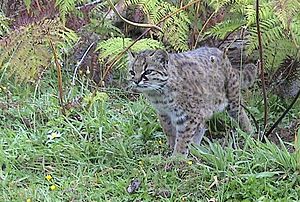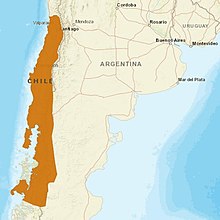Chilean forest cat
| Chilean forest cat | ||||||||||||
|---|---|---|---|---|---|---|---|---|---|---|---|---|

Chilean Forest Cat ( Leopardus guigna ) |
||||||||||||
| Systematics | ||||||||||||
|
||||||||||||
| Scientific name | ||||||||||||
| Leopardus guigna | ||||||||||||
| ( Molina , 1782) |
The Chilean forest cat ( Leopardus guigna , syn .: Oncifelis guigna ), also known as Kodkod or night cat , is the smallest South American wild cat within the family of cats (Felidae). It is native to the southwest of South America and is listed in the Red List of Endangered Species of the International Union for Conservation of Nature ( IUCN) as Vulnerable , as the total population is estimated to be less than 10,000 adult individuals, with a decreasing population trend.
features
The Chilean forest cat is - next to the African black-footed cat - one of the smallest of all wild cat species. The Chilean forest cat has a head body length of 40–50 cm and weighs between two and three kilograms. The fur is gray to beige in color and covered with small black spots. Compared to the closely related small spotted cat ( Leopardus geoffroyi ), this species has a significantly narrower face. Their paws are broad, the tail rather bushy and about 20-25 cm long. The back of the ears is black with a noticeable white spot. Pure blacks are more common in this species, especially in higher mountain areas. In Chiloé and the Guaitecas Islands , the black shape is the main shape.
The life expectancy of the Kodkod is about eleven years.
Distribution and habitat
The Chilean forest cat lives in the forests of central and southern Chile and the adjacent part of Argentina . It is also native to the islands off the Chilean coast, for example Chiloé, and is particularly common due to the lack of enemies.
In their homeland, the cat is found at heights up to the tree line at 1900 to 2500 meters. It is very closely tied to the damp mixed forests of the southern Andes and the coastal regions, especially to the evergreen temperate rainforests with heavy grass growth in the undergrowth. The habitat in Argentina is also characterized by mixed forests with heavy undergrowth, epiphytes and lianas . In addition to these areas, the Chilean forest cat can also be found much less frequently in the deciduous rainforest areas, as well as in the damp scrubland and in coniferous forests.
From the named bushland, only one specimen from the Valparaíso area has so far been described. This specimen was noticeably brighter than its relatives in the rainforests, which is why it was described as a separate subspecies with the name Og molinae , which is, however, not recognized.
The Chilean Forest Cat is quite insensitive to changes and colonization and it also lives in the vicinity of towns or cultivated agricultural areas. The area around Valparaíso, for example, where the cat is still at home today, has been permanently settled for over 1,000 years and was completely cleared around 150 years ago with the exception of a few forest islands .
Way of life
Not too much is known about the way of life of the Chilean Forest Cat. It climbs well and hunts birds, smaller reptiles and small mammals. The latter are mainly mouse-sized animals that are only hunted on the ground, croissants and other tree- dwelling animals are not hunted by cats. The males are supposed to rob chicken coops occasionally, the females are too small for that. It is assumed that the cat is mainly nocturnal, however, observations in the zoo revealed that the main activity was during the day.
No more precise information about social behavior is guaranteed. Rumors about a strong social behavior up to the formation of packs have not yet been confirmed.
The gestation period is about 10 weeks. There are two to three young in the litter.
threat
The Chilean forest cat is threatened mainly by the deforestation of the forest , the subsequent reforestation with pine trees and the agricultural use of the land. Their habitat is fragmented, especially in central Chile .
Hunting poses a minor threat, although it is also shot by local farmers as a potential animal predator, especially for poultry. Cats are also occasionally killed in illegal fox hunts, but forest cat skins are very rarely put on the market.
natural reserve
There are a number of protected areas in the range of the Chilean Forest Cat. It is under nature protection in Chile and Argentina and is listed in Appendix II of the Washington Convention on the Protection of Species . International trade and cross-border transfers of live specimens and body parts are prohibited without the approval of the relevant national authorities.
The zoo in Santiago de Chile keeps a single male specimen.
Taxonomy
According to some zoologists, the Chilean forest cat is not an independent species, but a subspecies of the small spotted cat. Molecular biological studies have shown that both species are closely related, so that they definitely represent sister species, the closest related species is the pampas cat ( L. colocolo ).
There are disagreements on the question of genre affiliation. In older works, the Chilean forest cat - like almost all cats - was classified as Felis guigna in the genus Felis , later it was grouped with the two species mentioned above to the genus Oncifelis . The most recent systematics such as Wilson & Reeder (2005) finally classify this genus with the leopard cats ( Leopardus ), the most famous representative of which is the ocelot .
There are two subspecies:
- Leopardus guigna trigillo (central Chile, no spots on the feet)
- Leopardus guigna guigna (southern Chile, smaller, lighter, spots on the feet)
etymology
Both the scientific name L. guigna and the regional name Kodkod come from the South American homeland of the Chilean forest cat. Thus, it is believed that Kodkod a Spanish acquisition of the name 'colocolo' from the dialect of the Mapuche is actually the pampas cat ( L. colocolo names). La güiña, on the other hand, is the local Spanish name for the cat.
Individual evidence
- ↑ a b c Acosta, G., Lucherini, M. (2008) Leopardus guigna . In: IUCN 2010. IUCN Red List of Threatened Species. Version 2010.4.
- ↑ Sanderson, J., Sunquist, M. Iriarte, A. (2002) Natural History and Landscape-use of Guignas (Oncifelis guigna) on Isla Grande de Chiloé, Chile. Journal of Mammalogy , 83 (2): 608-613
- ^ Convention on International Trade in Endangered Species of Wild Fauna and Flora (1979) Text of the Convention. Article IV: Regulation of Trade in Specimens of Species Included in Appendix II Signed at Washington, DC, on March 3, 1973; Amended at Bonn, on June 22, 1979
- Jump up ↑ JP Slattery, WE Johnson, D. Goldman, SJ O'Brien: Phylogenetic reconstruction of South American felids defined by protein electrophoresis. in: J. Mol. Evol. 39 (3). 1994: 296-305, PMID 7932791
- ↑ DE Wilson and DM Reeder (2005) Leopardus guigna ( Memento of the original from May 22, 2011 in the Internet Archive ) Info: The archive link was inserted automatically and has not yet been checked. Please check the original and archive link according to the instructions and then remove this notice. Mammal Species of the World . 3. Edition. Johns Hopkins University Press, 2005. ISBN 0-8018-8221-4
literature
- Nigel Dunstone, Leon Durbin, Ian Wyllie, Rachel Freer, Gerardo Acosta Jamett, Marcelo Mazzolli and Sam Rose: Spatial organization, ranging behavior and habitat use of the kodkod ( Oncifelis guigna ) in southern Chile. In: Journal of Zoology. 257. 2002: 1-11 Abstract
